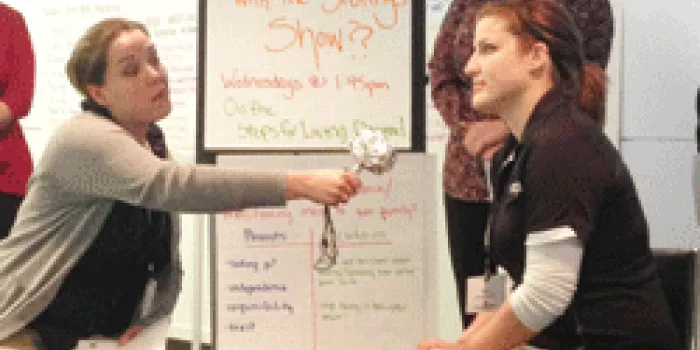The National Hemophilia Foundation (NHF) provides training for its chapters and other community members to support its programs. As part of that effort, NHF has spent the past few months preparing for 2013 Walks and helping chapters and hemophilia treatment centers (HTCs) work together to use Steps for Living to create programs for adolescents and young adults.
The Walk training, which took place January 13–15 in Winston-Salem, North Carolina, had approximately 65 people representing 28 chapters and NHF staff. The focus was to explain the program to new Walk chapters and to allow chapters that previously held Walks to share ideas.
“For new chapters, especially smaller ones, that have never done a fundraising event as large as a Walk, it can seem very intimidating,” says Kristin Hokoyama, national development manager of special events for NHF. She oversaw the training. Hearing from other chapters about how they managed time and resources helped new chapters.
The training also encouraged participants to take a hard look at numbers. It’s important for chapters to review their metrics, Hokoyama says, to plan their fundraising goals.
Chapters raise money for the Walks through teams of walkers that fundraise as a group, local sponsors who contribute funds and individual walkers. Chapters need to assess how much money was raised by each of those sources in the previous year to set a realistic fundraising goal—one that encourages growth, but doesn’t place a disproportionate share of the fundraising burden on any one source.
About half of the NHF chapters are currently participating in the Walk program. With a goal of the Hemophilia Walks becoming a nationally recognized event, chapters must plan their growth carefully. For instance, the Lone Star Chapter of NHF now holds its original Walk in Houston and another in Austin. It is considering adding a third location. “It’s a great example of a chapter expanding a program that helps both them and their community,” Hokoyama says.
Chapters and HTCs were encouraged to work together on programming for NHF’s Steps for Living training series, which helps chapters and HTCs engage children, adolescents and young adults. The first training was held in Atlanta on January 9–11. The Steps for Living training picks up where NHF’s First Step program, which helped chapters aid newly diagnosed families, left off. It follows the stages outlined on the Steps for Living Web site, adding Next Step (ages 9–15) and Step Up (ages 16–25).
During the Steps for Living three-day training, representatives from seven chapters and HTCs followed detailed lesson plans that can be used at annual meetings, retreats and other events. “We wanted to focus our energies on programs for preteens, teens and young adults,” says Christie VanHorne, MEd, MPH, NHF manager of education, who created the training. The program for younger kids includes bullying prevention, sibling rivalry and support, and mother-daughter discussions. For older children, the focus is on preparing for life after high school, independence, adherence and dating.
Kristi Harvey-Simi, executive director of the Nebraska Chapter of NHF, is enthusiastic about what she learned. “A lot of chapters don’t have a full-time staff position devoted to programs,” she says. She has already planned to incorporate the sibling program into her chapter’s Family Education Weekend.
Briana Vieke, program director at Hemophilia of Indiana, was pleased with the hands-on approach to the training. “It was all interactive, and the subjects covered were current—all things we need,” she says.
The second Steps for Living training will take place in Denver on April 20–May 2, and the third is scheduled for the fall of 2013 in Philadelphia.

